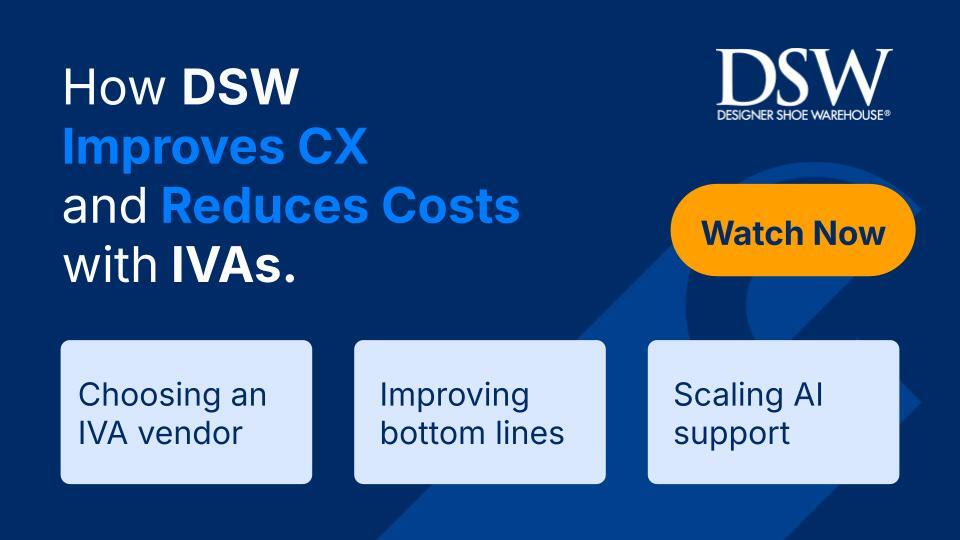Low-code automation is a process that uses low-code tools to create and deploy business applications. These platforms enable business users without coding skills to develop software solutions, including enterprise process automation. Low-code automation has gained much traction in recent years as more and more businesses are looking for ways to speed up the application development process. However, there are still many misconceptions about low-code automation.
What is a low-code platform?
Low-code development platforms offer a visual programming environment that uses drag-and-drop interfaces to develop applications. To build software solutions, these platforms typically use graphical user interface (GUI) components such as forms, buttons, and menus.
There are many low-code automation tools available. However, low-code development platforms generally fall into three categories: low-code application platform as a service (PaaS), low-code rapid application development (RAD) tools, and low-code enterprise architecture solutions.
What are low-code application platforms used for?
Low-code development tools can create a wide range of business applications. Some low-code software applications provide prebuilt components that can be used to develop mobile and web apps quickly. In contrast, others have tools for designing databases, creating reports and dashboards, and more.
Below are some low-code development projects that can be completed using a low-code platform:
- Development of mobile and web applications
- Data integration, migration, and processing
- Business process automation (BPA)
- Application Integration
Enterprise application development (EAD) low-code platforms are known for their low learning curve. Users without coding experience can use low-code tools to build applications in a fraction of the time it would take to develop an app with traditional methods.
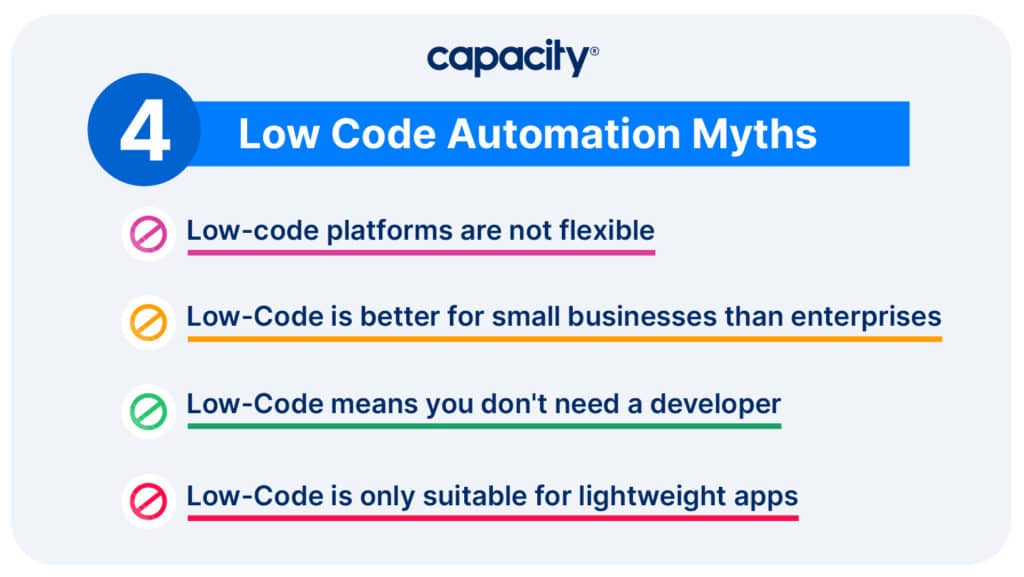
4 Low code Myths vs. Reality
There are a lot of myths about low code/no code software. Here are 4 to remember as you bring allow code software to your organization.
Myth #1: Low-code platforms are not flexible
One of the biggest low-code automation myths is that a low-code development platform is not flexible. However, low-code automation platforms are flexible and allow users to create apps without coding skills. A low-code environment features drag-and-drop interfaces that enable users to visually design their applications by adding prebuilt components from a palette or database. These low-code platforms can also work with large data sets and integrate with other systems.
Many businesses believe that low-code is not flexible because they need to become more familiar with the full capabilities of low-code automation. Recent developments have made creating complex applications with low-code platforms easier than ever.
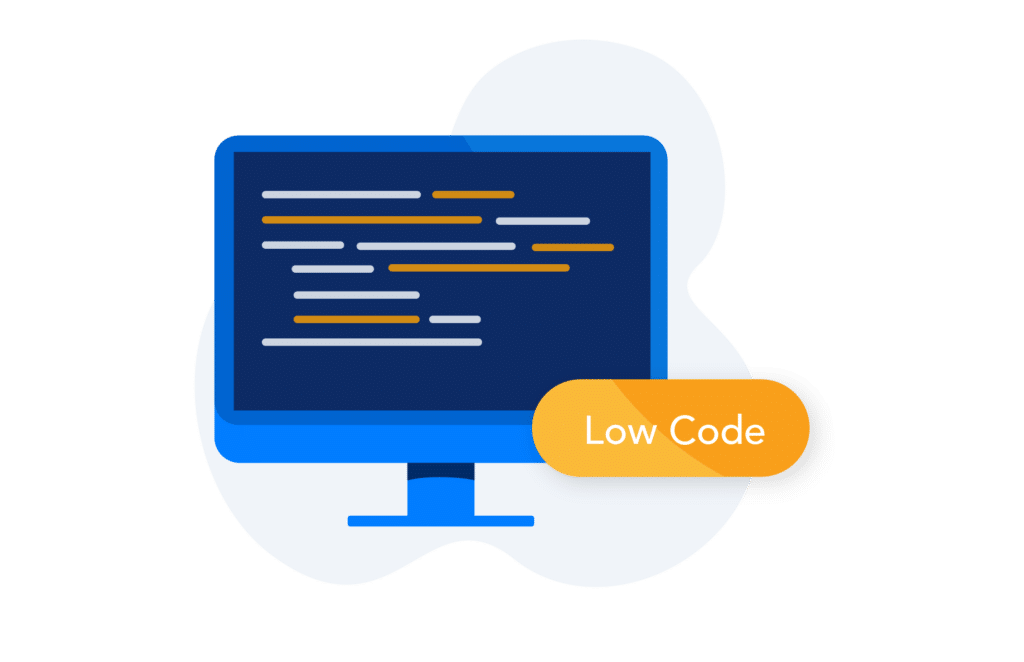
Myth #2: Low-Code is better for small businesses than enterprises
Another low-code automation myth is that low-code solutions are only better for small businesses and startups, not enterprises. This could not be further from the truth. The reality is that low-code development platforms are used increasingly by large enterprises daily. A low-code development platform is ideal for large enterprises because they allow businesses to quickly develop and deploy applications without hiring a large team of developers.
In addition, low-code applications are very flexible and allow business users to create apps without coding skills. This makes low-code automation an excellent option for any business that wants to get its applications up and running quickly.
Myth #3: Low-Code means you don’t need a developer
Another common low-code automation myth is that low-code solutions only benefit non-developers. However, low-code applications allow developers to use their preferred languages, such as Python or Ruby. Developers can also benefit from low code because they can write code in a visual environment, so they don’t have to type out every single line of code.
Low-code automation is an excellent option for developers who want to create applications quickly and easily. It means that developers can hire a small team of freelancers to help them with the development process. In addition, low-code applications make it easy for developers to collaborate with other team members on large projects.
Myth #4: Low-Code is only suitable for lightweight apps
Another common low-code automation myth is that low-code is only good for lightweight apps. However, low-code platforms can be used to develop complex applications. For example, low code can create an enterprise resource planning (ERP) system. Low-code platforms can also be used to develop mobile applications and web services.
How low-code automation can save money and time
Companies must automate their business processes to stay competitive in the digital transformation era. However, they often need more time or resources for traditional coding. Finding, hiring, and training the right developers to build custom automation scripts can take weeks or months.
Capacity is a low-code support automation platform that makes it easy for anyone to quickly create and deploy robotic process automation (RPA) without coding. With Capacity, companies can automate business processes in minutes, not months. Capacity has intuitive features, such as a drag-and-drop interface, a visual development environment, and point-and-click automation.
The Benefits Of Low Code Workflow Automation For Your Business
Workflow automation is necessary for any modern-day business, but finding the time and resources to do this can be challenging. Most companies are too busy with day-to-day operations to take on new projects that will help their company grow. This leaves businesses stuck in an endless cycle of doing things manually, which can be frustrating and inefficient.
A support automation platform like Capacity can provide low code workflow automation for your organization by allowing you to automate workflows without hiring expensive developers or IT staff.
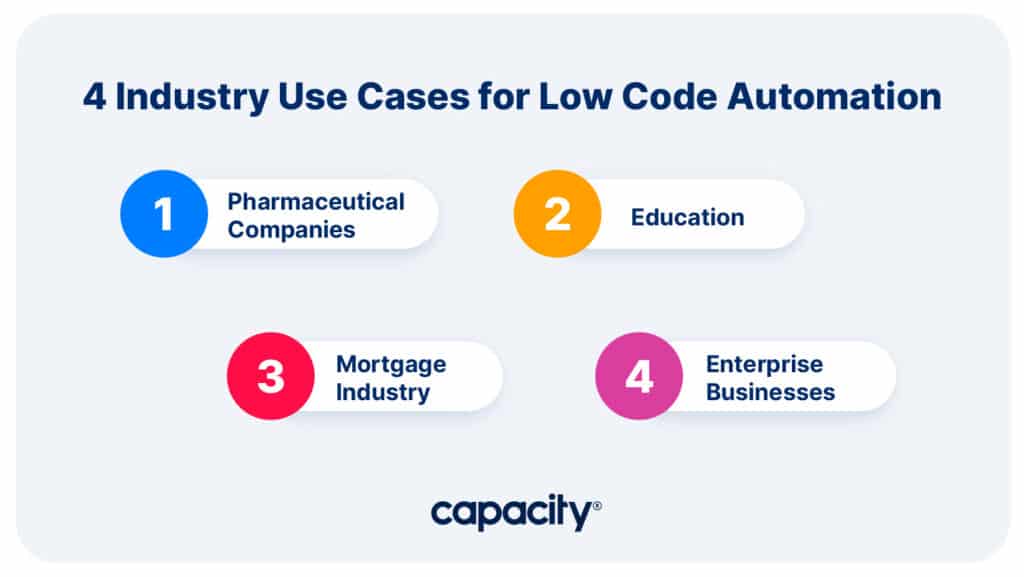
4 industry use cases for low code automation
Low code automation can be used for many different industries and processes. Here are some of the most common applications of low-code automation platforms:
1. Low-code platforms and pharmaceutical companies
Pharmaceutical companies spend a lot of time and money on improving their processes.
But they often fail to deliver the expected results because they need the right tools for managing complex workflows.
Capacity is a powerful workflow management tool that helps pharmaceutical teams improve efficiency, automate repetitive tasks, and streamline department communication. The platform can manage any workflow, but we’ve found that customers like to use it to manage clinical trials and regulatory submission workflows.
2. Low-code platforms for education
Schools are constantly evolving to provide quality education to students. Process automation is at the center of this evolution.
Universities can attract, engage, and retain students with Capacity. The easy-to-use platform helps faculty and staff with new student onboarding and general student support, so they can focus on tasks that require higher-level thinking. Capacity also automates standard processes and can be used as a virtual teaching assistant.
Capacity drives the next generation of self-service and helps students stay the course from orientation to graduation.
3. Low code platform for the Mortgage Industry
The mortgage industry has many moving parts, which can get complicated for lenders and borrowers. A support automation platform can help automate tedious processes and tasks with low-code workflows to increase productivity in cross‑functional teams.
Capacity provides process and support automation for lenders. Through support automation, mortgage companies realize a drastic reduction in emails, phone calls, and tickets while providing faster response times. Through process automation, mortgage companies reduce the time spent on repetitive tasks and eliminate bottlenecks, freeing up their time for relationship-building and revenue-generating activities.
With Capacity, you can automate tedious workflows, allowing loan officers more time to personalize conversations with potential clients instead of spending hours searching through documents for answers they don’t have at their fingertips.
Mortgage professionals use Capacity to effortlessly tap into critical systems like Ellie Mae, Encompass, and AllRegs to provide real-time access throughout the loan life cycle. Your clients will benefit from a superior customer experience with 24/7 tier 0 and 1 support. Capacity connects apps, mines documents, captures tacit knowledge, and automates processes through a mobile-friendly chat interface. Capacity’s conversational interface is easily embedded right on your website.
4. Low code software for Enterprise businesses
Businesses don’t have time to waste on monotonous tasks, and neither do their employees. This is why more and more companies are turning to support automation platforms, like Capacity, to automate workflows and improve customer and employee experiences.
Most businesses today use spreadsheets and emails to get work done. This type of workflow could be faster, more manual, and error-prone. Because of this, disorganization is ever-present, and tasks are bound to slip through the cracks.
Low code software: The bottom line
Capacity brings order to chaos by automating a company’s most critical workflows, allowing businesses to focus on growth. With Capacity, organizations can manage client relationships from lead generation through onboarding without ever leaving Slack or Microsoft Teams.
Our software integrates with your favorite cloud apps, like Salesforce and DocuSign, so you can put Big Data and human relationships to work for you.
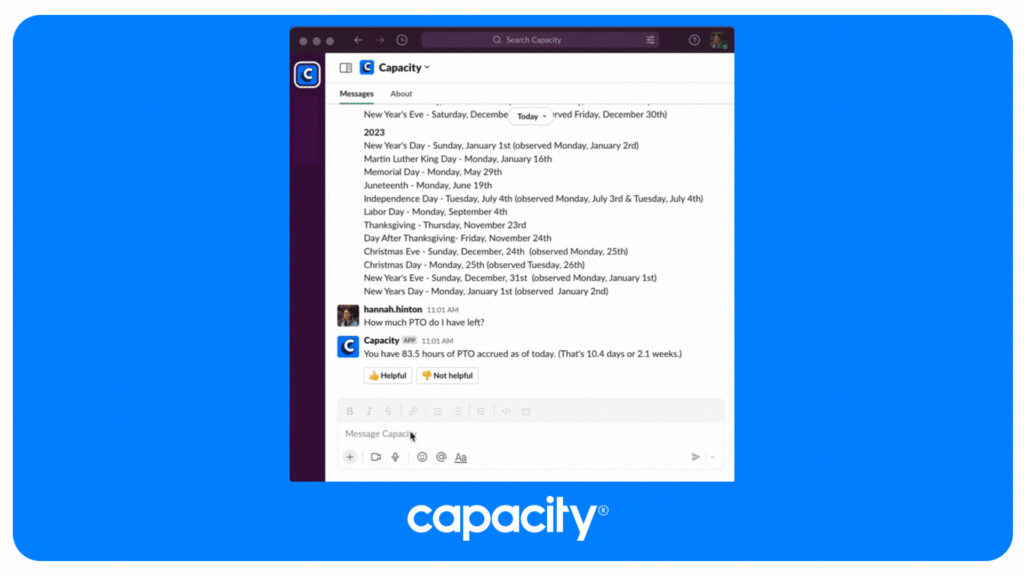
Get started with Capacity
Capacity’s low code platform allows businesses to automate their workflows. Plus, it has powerful AI functionality that learns from each user interaction to provide a personalized experience for everyone in your business.
Capacity is 100% cloud-based, has an easy-to-use interface, and offers unlimited integrations.
If you struggle to automate routine business processes and need support bringing front-end and back-end systems together, Capacity can help.











































